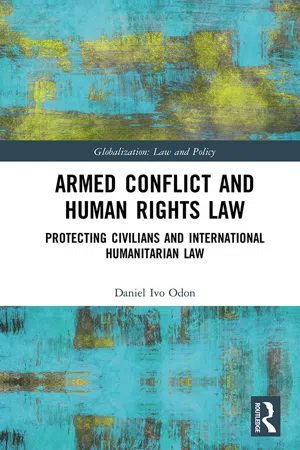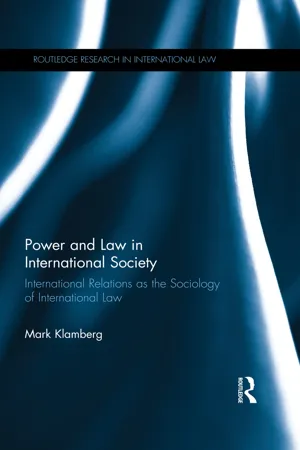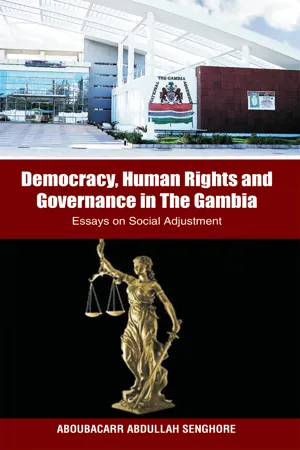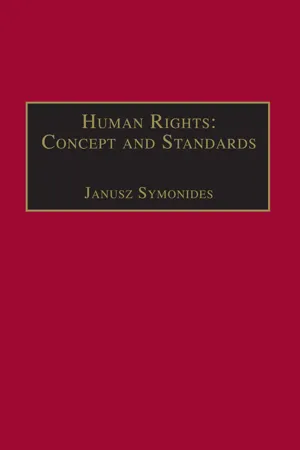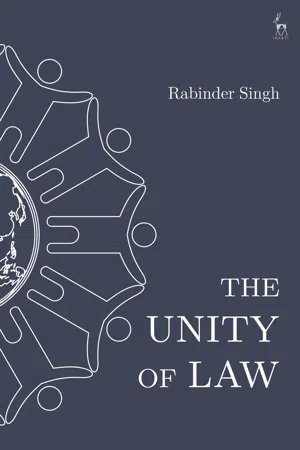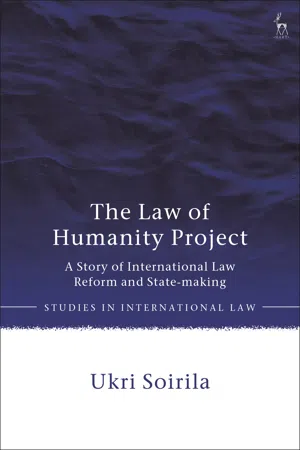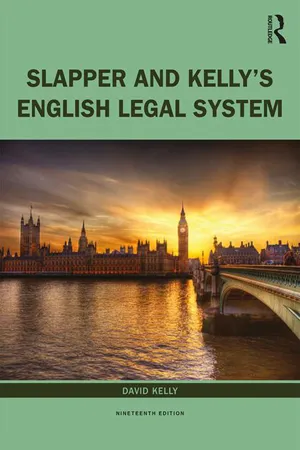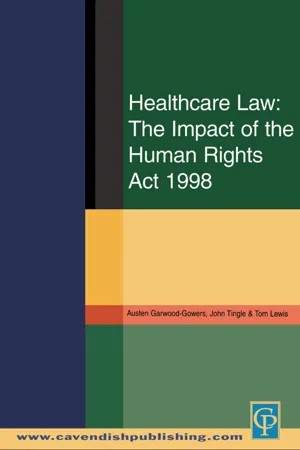Law
Human Rights Law
Human rights law encompasses the body of international and domestic laws that protect and promote the fundamental rights and freedoms of individuals. It includes treaties, conventions, and domestic legislation that address issues such as equality, non-discrimination, freedom of speech, and the right to a fair trial. Human rights law aims to ensure that all individuals are treated with dignity and respect.
Written by Perlego with AI-assistance
Related key terms
10 Key excerpts on "Human Rights Law"
- eBook - ePub
The Legalization of Human Rights
Multidisciplinary Perspectives on Human Rights and Human Rights Law
- Saladin Meckled-García, Basak Çali(Authors)
- 2006(Publication Date)
- Routledge(Publisher)
The features explained by NRM, then, include who the rights apply to (who the right holder is), who they impose duties upon (the duty bearer), the content of the duties, and what constitutes adequate securing (in line with these respective duties), and the source of interpretation in settling issues of conflict of interests and rights. It is these features that will be shown to diverge substantively from Human Rights Law. To show that this is the case, we will take each apparent divergence and try to bring to bear moral considerations relating to the human rights ideal which might justify the apparent divergence.International Human Rights Law
By Human Rights Law we mean something quite precise: a form of public international law creating rights for individuals and duties for states, as well as domestic and international remedies for violation of rights and failure of duties. International treaties and customs that deal with human rights have a different character to those that deal with war crimes, crimes against humanity and genocide. We do not consider the latter to be part of the body of Human Rights Law proper, although they all come under the broad category of humanitarian concern. Their subject matter is often, and in our view wrongly, elided with Human Rights Law, simply because both are concerned with the protection of people against abuses. 6 However, the similarities stop there. Human rights provisions are those which give entitlements to individual persons, individually or in some cases collectively, to make legal claims before public authorities and where the legal support for these claims is said to respect these individuals’ entitlements as human persons (Feinberg 1980, 2003).IHRL is constituted by that set of international instruments and institutions which explicitly determine the human rights of persons. It includes the international and regional human rights obligations of states, either stemming from international treaties or customary international law. 7 - eBook - ePub
Armed Conflict and Human Rights Law
Protecting Civilians and International Humanitarian Law
- Daniel Ivo Odon(Author)
- 2021(Publication Date)
- Routledge(Publisher)
19Summing up, the law of human rights is deeply rooted in moral philosophy. Even after the Second World War, modern international law of human rights has been indissolubly linked with moral concerns.20 All conflicts addressed by human rights are also moral conflicts, and through the development of the modern international community, which accounts for plural subjects and sources of law dynamism, human dignity has served as a guide for human rights conflict resolutions appeasement. Both old and new human rights frameworks have had the same overall aim to construct a world that is more peaceful and humane, which would lead to the vanishing of war and all forms of human cruelty and barbarism.21The rise of human rights morality
As stated in Article 1 of UDHR, “all human beings are born free and equal in dignity and rights”. Since the birth of human rights in the American Declaration of Independence in 1776 and the French Declaration of the Rights of Man and Citizen of 1789 (where the correlated statement was “men are born and remain free and equal in rights”), the words equality in dignity and rights have been added. This subtle change encompasses a substantial reform of what we conceive as human rights and, most of all, who we perceive as human beings.A context of value is merged with human rights comprehension – considered human values acquired through the history of mankind – to comprise the juridical inventory of humanity . 22 Although the process of modernization might seem to bring a decline or erosion of values, in fact it has proven the opposite. Too many atrocities and cruelty were perpetrated during the building process of human rights. In general, human rights transgressions are diminishing, while human dignity is being emphatically advocated, which might be due to several reasons.23 However, one of the most important is that the notion of human dignity embraced by human rights encompasses human values related to religious and cultural traditions. These values are associated with a general duty to help people who are suffering, independent of who or where they are. Thinking around human dignity therefore emphasizes (i) the sacredness of human life, (ii) an ethos of love and (iii) universal respect.24 - eBook - ePub
Power and Law in International Society
International Relations as the Sociology of International Law
- Mark Klamberg(Author)
- 2015(Publication Date)
- Routledge(Publisher)
1 When a state violates a human rights norm, no other state directly suffers harm. Rather, the primary concern of Human Rights Law is what happens inside a state.Different human rights address different needs. This part of the study will focus on the core UN human rights treaties, the main regional human rights treaties and the institutions associated with these treaties. Consistent with the argument made in section 2.2.1 on the objectives of international law, Human Rights Law is a product of competing interests. Much of international Human Rights Law codifies state’s interests, rather than human interests,2 as illustrated by the fact that several specific human rights may be subject to restrictions in order to satisfy state interests.5.2 Dimensions of legalization
5.2.1 Degree to which rules are obligatory
In addition to the nine international human treaties of the UN,3 there are several regional human rights treaties.4 The degree of ratification varies which, to some extent, is compensated by the fact that core human rights, such as the prohibitions against racial discrimination and torture, are also rights under international customary law.5 However, states with different types of ideologies and political structures place different values on different rights. Thus, not all rights are universally obligatory even when considering international customary law. The discretion of states to prioritize certain rights in their structure is amplified by the lack of precision, as explained in the next section.5.2.2 Precision of rules
Human Rights Law protects several different rights, not all of which are absolute. The possibilities to make exceptions or limit the exercise of these rights will impact on the precision of the rules. - eBook - ePub
Democracy, Human Rights and Governance in The Gambia:
Essays on Social Adjustment
- Abdullah Senghore(Author)
- 2018(Publication Date)
- CENMEDRA(Publisher)
30 Finally, a closer look at the five fundamental values that, according to Muslim jurists, Shariah has been revealed to protect and preserve, clearly shows that Islamic law has in actual fact adequately guaranteed the protection and ensured the means of actualization of all fundamental human rights and basic freedoms incorporated in the international human rights conventions and treaties of contemporary times i.e. the protection of life, religion, intellect, progeny and property has definitely included all the civil, political, economic, social and cultural rights protected by the modern international law of human rights and various national laws of the nation states of contemporary times.I.d. Can the Concept of Human Rights be Universally and Comprehensively Defined? And What Significance will that Definition Make?As the above discussion of the nature of rights reveals there can be no single universal and comprehensive definition for the concept of human rights. The various philosophical perspectives just highlighted above stand to contradict one another. So to give a single definition comprehensive enough to be accepted by all is out of the question. Similarly, the continuing debate and controversy between the theories of universality and cultural relativism over the scope and relevance of human rights is another factor ruling out the possibility of providing such a definition. While any definition by the proponents of the universality theory would stress the universal, indivisible, interdependent and interrelated character of human rights and that they have to be placed beyond the limits of domestic jurisdiction, the cultural relativists would advance a definition which emphasizes the need to consider human rights in their ideological, regional and national context and on the principle of respect for and non interference in the internal affairs of a sovereign state. However, given that the concept or term “rights” is used to describe a variety of relationships the following description of the concept may be recognized (although it sounds influenced by the theory of natural rights): Human Rights are those fundamental values inherent in every individual human being on the basis of humanity and recognized by law both domestic and international. - eBook - ePub
- Janusz Symonides(Author)
- 2017(Publication Date)
- Routledge(Publisher)
Most human rights, including economic and social rights, contain some elements which can be dealt with at the national level as subjective rights. For these, individuals can have an effective remedy through competent national tribunals or courts in the case of violations.Other aspects of the same rights are less amenable to direct transformation into subjective rights. They are, at least initially, elements of a right to a social order in which the particular rights can be realized. The process of realization forms part of state obligations under international law.If, by subjective legal rights, we refer to rights which will be upheld by a court when an individual brings a claim alleging violations, and if we limit ourselves for the time being to domestic courts (within a given national legal system), several conditions would have to be fulfilled for international human rights to be a legal right in that particular setting: what is the position of international Human Rights Law in domestic law? Is it directly applicable or does it have to be incorporated into national law in one way or another? If international Human Rights Law is directly applicable, the next question is whether the particular right in question is self-executing or whether it has to be given a more specific form and content in domestic legislation in order to become applicable by domestic courts. If the position of international Human Rights Law in domestic law depends on some form of incorporation, the question whether it is a legal right under domestic law depends on the nature and scope of that incorporation and also whether the particular international human right is self-executing.There is no guarantee for any international human rights that they will be treated as legal rights in domestic law, but some are more easily accepted than others. This, however, also depends on the political and cultural system of the society concerned. The overall purpose of the International Bill of Human Rights is to promote their acceptance within all domestic systems and, as far as possible, also to make them into legal rights within domestic systems. However, not all international human rights lend themselves easily to being made justiciable in domestic systems, nor is it obvious that all aspects should be justiciable. - eBook - ePub
- Bruce Bueno de Mesquita(Author)
- 2013(Publication Date)
- CQ Press(Publisher)
If we contemplate the impact of audience costs on crisis escalation, we see the hand of human rights in the form of free speech and free, competitive elections at work. If we look at the decisions politicians must make between satisfying current economic demands and the long-term environmental well-being of their citizens, we see human rights at work. Wherever we turn, for better or worse, we see how government choices respond to the presence or absence of human rights, especially core freedom rights like free speech, free press, and freedom of assembly. With that in mind, we will explore the relative performance of different governments on human rights especially after they have signed international treaties to respect these rights. This specific setting puts together arguments about norms, law, interests, and strategic choice, providing a firm ground to evaluate the merits of competing theories. By forming a better understanding of human rights, the force of promises, the force of law, and the force of domestic politics, we can expand our appreciation of when law or norms work and when they don’t. And we can come to grips with the harsh reality behind the suppression of the three freedoms that I have highlighted as crucial for good governance: freedom of speech, freedom of the press, and freedom of assembly. Before we turn to the subtleties of the interaction between human rights and international law, norms, and domestic constraints, we ought to look first at what is meant by international law and by norms-enforcing international regimes. Within the discussion of international law, we will especially want to explore what the role is of treaties, particularly human rights treaties. And in exploring regimes we will probe the meaning of norms of conduct and how they are expected to shape behavior - eBook - ePub
- Rabinder Singh(Author)
- 2021(Publication Date)
- Hart Publishing(Publisher)
It seems to me that several more answers need to be given as to why a human rights charter like the Human Rights Act does not set out a list of duties and responsibilities as well. The first answer is that actually to some extent it does. For example, the text of article 10(2) of the European Convention expressly refers to the ‘duties and responsibilities’ which accompany the right to freedom of expression. There is a deeper point here. As I mentioned at the outset, the European Convention is descended from the Universal Declaration of Human Rights, to which it refers in its preamble. Article 29(1) of the Declaration provides that: ‘Everyone has duties to the community in which alone the free and full development of his personality is possible’.The whole of the law of human rights is infused with notions of balance between the rights of the individual and the general interest. It is untrue and alarmist when it is suggested that Human Rights Law allows criminals to escape detection or punishment or that the rights of a wrongdoer can never be limited or curtailed. Very few rights are absolute. The one major exception is the rule against torture. Most rights can be restricted provided this is done in accordance with law, for a legitimate purpose such as the prevention of crime or disorder or for the protection of the rights of others and (most importantly) provided a fair balance is struck in accordance with the principle of proportionality.The second part of the answer, it seems to me, is that in fact the whole of the rest of the law sets out a person’s duties. If you go just to the criminal law part of any series of statutes, you will see laws that now run into thousands. And of course in England, many criminal offences are still offences at common law and have not been codified in legislation. And then there are all the duties imposed by the civil law. The whole point of a bill of rights is to have a short, simple statement of a person’s basic rights which can be relied upon as an enclave or oasis within the vast framework of the rest of the legal system. - eBook - ePub
The Law of Humanity Project
A Story of International Law Reform and State-making
- Ukri Soirila(Author)
- 2021(Publication Date)
- Hart Publishing(Publisher)
3Concepts of Law of HumanityA t the heart of the law of humanity discourse lays an assumption that the increased circulation of the key law of humanity concepts – namely, human rights, human security and human dignity – will transform international law into law of humanity and improve the lives of individuals everywhere. In this chapter, I will engage with this assumption by analysing each of the aforementioned concepts in turn. My argument is that, due to their indeterminacy, the concepts can be used to achieve multiple purposes; not only those sought by the law of humanity theorists. Hence, there are no guarantees that the increased reference to the concepts will necessarily bring about the outcomes desired by the law of humanity theorists.I. THE PROMISES AND THE CHALLENGESThe concepts of human rights, human security and human dignity all hold great promise for the law of humanity project. At the heart of the project lies the notion that persons are bearers of inalienable human rights, always and everywhere.1 Although Anne Peters has recently emphasised that individual rights in the international legal system cannot be reduced to human rights2 and Rafael Domingo has treated human rights most of all as a tool for protecting human dignity,3 human rights are nevertheless a fundamental building block of the project. This is so for at least four reasons. First, international Human Rights Law – along with international criminal law and international investment law – has played a crucial part in putting the individual on the map of international law. Second, as the importance of international Human Rights Law grew, it started to affect more traditional areas of international law through interpretation. As both Canҫado Trindade and Merón have argued, human rights have produced a ripple effect with the consequence that human rights considerations now permeate almost the entire plane of international law.4 Third, human rights are seen to help in the law of humanity project’s attempt to reduce the role of states in international law and/or to relativise state sovereignty.5 Finally, human rights are supposed to alter the structure of international law, providing it with a new foundation by changing the way we perceive law at the global level. Indeed, international Human Rights Law tends to emphasise its special character and thus construct itself ‘in direct opposition to the tried and tested methods of international law’.6 Whereas international law is often seen to be trapped in the ‘agnosticism of classical liberalism’, Human Rights Law is seen to resurrect the idea that there is some eternal core which law must serve and thus ‘put the international legal system on an entirely new footing, one that is much more geared towards the pursuit of a broad vision of justice’.7 - No longer available |Learn more
- David Kelly(Author)
- 2020(Publication Date)
- Routledge(Publisher)
Even allowing for this degree of judicial manoeuvring, the situation still remained unsatisfactory. Pressure groups did agitate for the incorporation of the ECHR into the UK legal system, but, when in 1995 a Private Member’s Bill moving for incorporation was introduced in the House of Lords, the Home Office minister, Lady Blatch, expressed the then Conservative government’s view that such incorporation was ‘undesirable and unnecessary, both in principle and practice’. The Labour opposition, however, was committed to the incorporation of the ECHR into UK law and, when it gained office in 1997, it immediately set about the process of incorporation. This process resulted in the Human Rights Act (HRA) 1998.2.5.1 RIGHTS PROVIDED UNDER THE EUROPEAN CONVENTION ON HUMAN RIGHTS
The Articles incorporated into UK law, and listed in Sched 1 to the Act, cover the following matters:- • the right to life. Article 2 states that ‘Everyone’s right to life shall be protected by law’;
- • prohibition of torture. Article 3 actually provides that ‘No one shall be subjected to torture or to inhuman or degrading treatment or punishment’;
- • prohibition of slavery and forced labour (Art 4);
- • the right to liberty and security. After stating the general right, Art 5 is mainly concerned with the conditions under which individuals can lawfully be deprived of their liberty;
- • the right to a fair trial. Article 6 provides that ‘everyone is entitled to a fair and public hearing within a reasonable time by an independent and impartial tribunal established by law’;
- • the general prohibition of the enactment of retrospective criminal offences. Article 7 does, however, recognise the post hoc criminalisation of previous behaviour where it is ‘criminal according to the general principles of law recognised by civilised nations’;
- • the right to respect for private and family life. Article 8 extends this right to cover a person’s home and their correspondence;
- • freedom of thought, conscience and religion (Art 9);
- • freedom of expression. Article 10 extends the right to include ‘freedom … to receive and impart information and ideas without interference by public authority and regardless of frontiers’;
- •
- Austen Garwood-Gowers, John Tingle, Tom Lewis(Authors)
- 2013(Publication Date)
- Routledge-Cavendish(Publisher)
CHAPTER 2THE HUMAN RIGHTS ACT 1998 AND THE COMMON LAW, A HEALTHCARE LAW PERSPECTIVE
John HodgsonCOMMON LAW RULES AND THE EUROPEAN CONVENTION
When the European Convention on Human Rights (ECHR) was drafted in 1949–50, the focus was on human rights writ large. It was part of the general post-war settlement, and was initially conceived as a regional version of the Universal Declaration of Human Rights.1 It was not until a late stage in the travaux préparatoires that a draft tabled by the UK delegation actually produced an enforcement mechanism.2 Even so the Preamble clearly indicates the relationship with the Universal Declaration:The governments signatory hereto, being members of the Council of Europe Considering the Universal Declaration of Human Rights proclaimed by the General Assembly of the United Nations on 10 December 1948; Considering that this Declaration aims at securing the universal and effective recognition and observance of the Rights therein declared;Considering that the aim of the Council of Europe is the achievement of greater unity between its members and that one of the methods by which that aim is to be pursued is the maintenance and further realisation of human rights and fundamental freedoms;Reaffirming their profound belief in those fundamental freedoms which are the foundation of justice and peace in the world and are best maintained on the one hand by an effective political democracy and on the other by a common understanding and observance of the human rights upon which they depend;Being resolved, as the governments of European countries which are likeminded and have a common heritage of political traditions, ideals, freedom and the rule of law, to take the first steps for the collective enforcement of certain of the rights stated in the Universal Declaration.While there is a specific guarantee of ‘due process’ in Art 5 (relating to the deprivation of liberty) and Art 6 (relating to trial), it is clear that these were specifically aimed at preventing a repetition of the arbitrary arrests of the GeStapo and other Nazi bodies and the mockery of legality in Freisler’s Volksgericht, with obvious reference to similar abuses in the remaining dictatorships of the left and right in Europe at the time.
Index pages curate the most relevant extracts from our library of academic textbooks. They’ve been created using an in-house natural language model (NLM), each adding context and meaning to key research topics.

